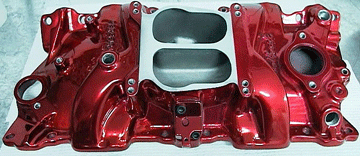Powder / Powdered Coating Review
Industrial Coating Types Knowledge Menu
Powder / Powdered Coating - Powder coating material is applied to parts using an electrostatic or compressed air techniques. The applied powder coat is then heated (cured) to the melting point of the power, which then the powdered coating flows to form a smooth thin film. After cooling, the powdered coating dries to form a durable finish, which is very resistant to scratches, cracking, peeling, UV rays and corrosion.
There are two types of powder coatings: Thermoplastic and Thermoset. Thermosetting incorporates a activator into the coating formulation. When the powder is baked to an elevated temperature, a reaction the powder polymer occurs and improves the mass performance of the powder coating properties. Thermoplastic application does not have any additional chemical reactions during the baking process, however will flow-out or leach onto the final coating.
The most common polymers used are polyester, polyester-epoxy (known as hybrid), straight epoxy (Fusion bonded epoxy) and acrylics. Typical powder coatings are applied to consumer and industrial products such as; bicycles, lawn furniture, office fixtures and furniture, automotive products, refrigerators, clothing washing and drying machines. Powdered coatings may present a cost saving alternative to petroleum based paints with respect to energy savings, labor costs, rework costs, material usage, waste disposal, and quality.
 Powder Coated Manifold |
|---|
Design Considerations for Powder Coatings
- Faraday Cage Effect
- Definition: Phenomenon of charged particles prevented from entering recessed areas due to curvature of electric force lines from nearest grounded surface.
- “Inside” corners have low film build or coverage voids due to Faraday Cage Effect.
- This phenomenon can be used to mask parts.
- Typical industrial powder thickness is 2 – 6 mil. Average target thickness 3.5 mil.
- To achieve lower film builds on specific areas, masking and racking solutions can be implemented. But these solutions also require tolerance allowances.
- Sharp Edges should be avoided due to excessive paint buildup.
- Edge coverage is complete on radii greater than 0.010”
- Due to Faraday Cage effects, expect powder to penetrate to depth equal to twice the width of the opening.
- Due to Faraday Cage effects, paint build can be severely impeded (thin paint) by acute angles and the proximity of other painted surfaces.